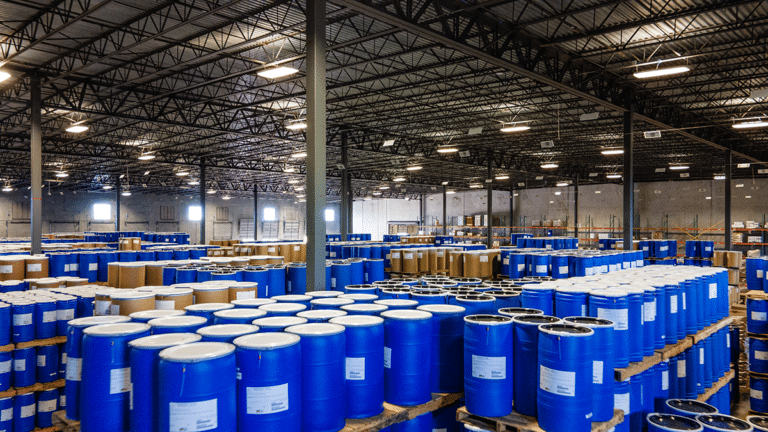The key to running an efficient and successful warehouse operation is to establish and maintain proper organizational tactics.
Warehouses can become overwhelming and disorganized quickly, especially during peak seasons.
But a disorganized warehouse can lead to lost productivity, unnecessary expenses, and decreased customer satisfaction. Implementation of best practices for warehouse organization can help businesses in streamlining their operations.
A well-organized warehouse not only saves time but also enhances productivity, which in turn translates into customer satisfaction and increased profits.
In this article, we’ll discuss the best practices for maintaining an organized warehouse, so your business can function smoothly and efficiently while delivering the best service to your customers.
Inventory Management
Proper inventory management is a key component of maintaining an organized warehouse.
We will discuss some of the best practices for maintaining an organized warehouse through effective inventory management.
Implement a Robust Inventory Control System
A good inventory system should ensure that accurate records are maintained for all items in the warehouse, including their location, quantity, and other pertinent details.
The system should also be capable of tracking the movements of items in and out of the warehouse.
Assign Locations for Each Item
To further maintain an organized warehouse, it is important to assign specific locations for each item.
This will make it easier to find items quickly when they are needed. The location should be recorded in the inventory control system to ensure that the system is updated with the correct information.
Establish Regular Inventory Audits
Regular inventory audits are essential to maintaining an organized warehouse. These audits provide an opportunity to verify the accuracy of the inventory control system, ensuring that the correct location and quantity of each item are recorded.
The audits can also help identify any discrepancies or errors in the system, enabling them to be corrected promptly.
Track Expiry Dates
In industries where products have a fixed shelf life or limited expiration dates, tracking the expiry dates is crucial.
This helps prevent expired products from taking up valuable space in the warehouse and ensures that customers receive only fresh products.
A robust inventory control system can track expiry dates and alert warehouse staff when it is time to pull or dispose of expired products.
Utilize Technology for Inventory Management
To keep pace with the demands of modern warehousing, it is important to utilize technology for effective inventory management.
This includes using scanners to efficiently track the movement of items in and out of the warehouse and investing in an inventory management software program.
Technology helps automate record keeping and makes it easier for workers to access accurate details about item locations and quantities.
Storage and Shelving
Proper storage and shelving can make a significant difference in keeping your workspace organized and efficient.
The best practices for maintaining an organized warehouse, particularly when it comes to storage and shelving are:
- Conduct an inventory check
- Use vertical space
- Categorize and label items
- Utilize pallet racking
- Implement FIFO (First In First Out)
- Install proper lighting
- Keep aisles clear
Proper storage and shelving can create more space, improve workplace safety, and increase productivity.
Remember to conduct regular inventory checks, use vertical space, categorize and label items, implement FIFO, install proper lighting, and keep aisles clear of clutter.
Equipment and Tools
Let’s explore the best practices for maintaining an organized warehouse through proper equipment and tool usage.
Proper maintenance of equipment
Proper maintenance of equipment in a warehouse involves regular cleaning and inspection, timely repairs and replacements, and adherence to safety protocols.
It is important to have a schedule for maintenance tasks such as oiling, lubricating, and tuning the equipment, as well as keeping records of the maintenance activities for future reference.
Ensuring that the equipment is used properly by trained personnel and not overloaded beyond capacity can help prevent breakdowns and accidents.
Overall, maintaining equipment in a warehouse requires a proactive and disciplined approach to ensure the efficiency, safety, and longevity of the equipment.
Safe use of warehouse tools
- Receive proper training on the specific tool and its safety features
- Always wear appropriate protective gear such as gloves, safety glasses, and steel-toed shoes.
- Follow the manufacturer’s instructions and guidelines for use, and inspect the tool before each use to ensure it is in good working condition.
- Keep the work area clean and organized to avoid tripping hazards and other accidents.
- When using power tools, always unplug them when not in use and never leave them unattended.
- Always use common sense and exercise caution when using any tool in a warehouse environment.
Ergonomic considerations
Ergonomic considerations in using equipment and tools in an organized warehouse include ensuring that equipment and tools are designed with proper height and weight to prevent strains and injuries.
In addition, equipment and tools should be placed in easily accessible areas to minimize bending and reaching, and proper ventilation and temperature control should be maintained to promote employee comfort and health.
Implementing automation and technology
Implementing automation and technology in an organized warehouse can greatly improve efficiency, accuracy, and productivity.
The key is to carefully plan and strategize the implementation process to ensure a smooth transition.
This includes analyzing and mapping out the current workflow, identifying the areas where automation and technology can be applied, selecting the appropriate tools and software, training staff on how to use the new system, and continuously monitoring and improving the process.
The benefits of implementing automation and technology in maintaining an organized warehouse can significantly outweigh the initial challenges and costs.
Cleaning and Maintenance
One of the most important components of keeping a warehouse organized is proper cleaning and maintenance.
Dirty and cluttered spaces can lead to accidents and decreased productivity.
Here are some best practices for maintaining an organized warehouse through cleaning and maintenance:
- Create a cleaning schedule
- Clear the clutter
- Prioritize safety
- Keep the floors clean
- Inspect your equipment regularly
- Enforce cleaning policies
- Use pest control measures
- Regular equipment maintenance
- Introduce safety protocols for hazardous materials
Training and Education
One way to maintain an organized warehouse is through training and education which can be accomplished by doing the following:
1. Train Employees on Warehouse Organization Techniques
As a first step, your employees should be trained in warehouse organization techniques.
This includes teaching them how to properly label and store items, as well as how to use equipment, such as shelving, pallets, and forklifts, to their advantage.
2. Develop an Orientation Program for New Hires
When you bring on new hires, it’s essential to provide them with an orientation program that includes a focus on warehouse organization.
This will help ensure that everyone is on the same page and working towards the same goals when it comes to warehouse organization.
3. Create Standard Operating Procedures (SOPs)
To maintain consistency in your warehouse organization practices, create standard operating procedures (SOPs) that outline the steps to be taken for storage, inventory, and order fulfillment.
SOPs should be documented and readily available to all employees, and they should be regularly reviewed and updated as needed.
4. Offer Regular Training Sessions
It’s essential to offer regular training sessions to employees to keep their skills and knowledge up-to-date.
This can include sessions on new warehouse organization techniques, technological advancements in warehousing, and any changes to company policies or SOPs.
Refresher courses can be especially helpful for employees who have been with the company for a while.
Related: 9 Traits of a Good Truck Driver Trainer and Mentor
5. Encourage Employee Feedback
It’s essential to create an environment in which employees are encouraged to provide feedback on warehouse organization practices.
Employees who work on the floor may have valuable insights and suggestions on how to improve processes, and their input can help make your warehouse more efficient and effective overall.
What Maintaining an Organized Warehouse Means to Your Business
An organized warehouse helps businesses to save time, money, and effort. A well-organized warehouse enables employees to access items easily and quickly, reducing the time taken to locate goods.
This leads to improved productivity and better customer service, as orders can be fulfilled promptly.
Furthermore, an organized warehouse allows for better inventory control, as it is easier to track stock levels, minimize lost or damaged inventory, and reduce instances of overstocking.
To know more about warehouse management, call us at Canal Cartage.
Our warehouse service is located close to Port Houston terminals. If you are a manufacturer, a distributor or an e-commerce retailer, your shipments can come from a variety of different merchants, imported through the Port of Houston.
Let us help you consolidate your freight conveniently, at our secure warehouse.



